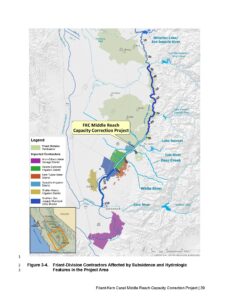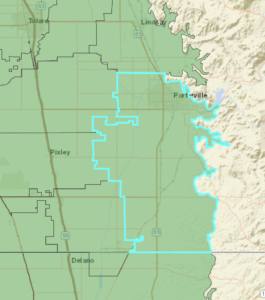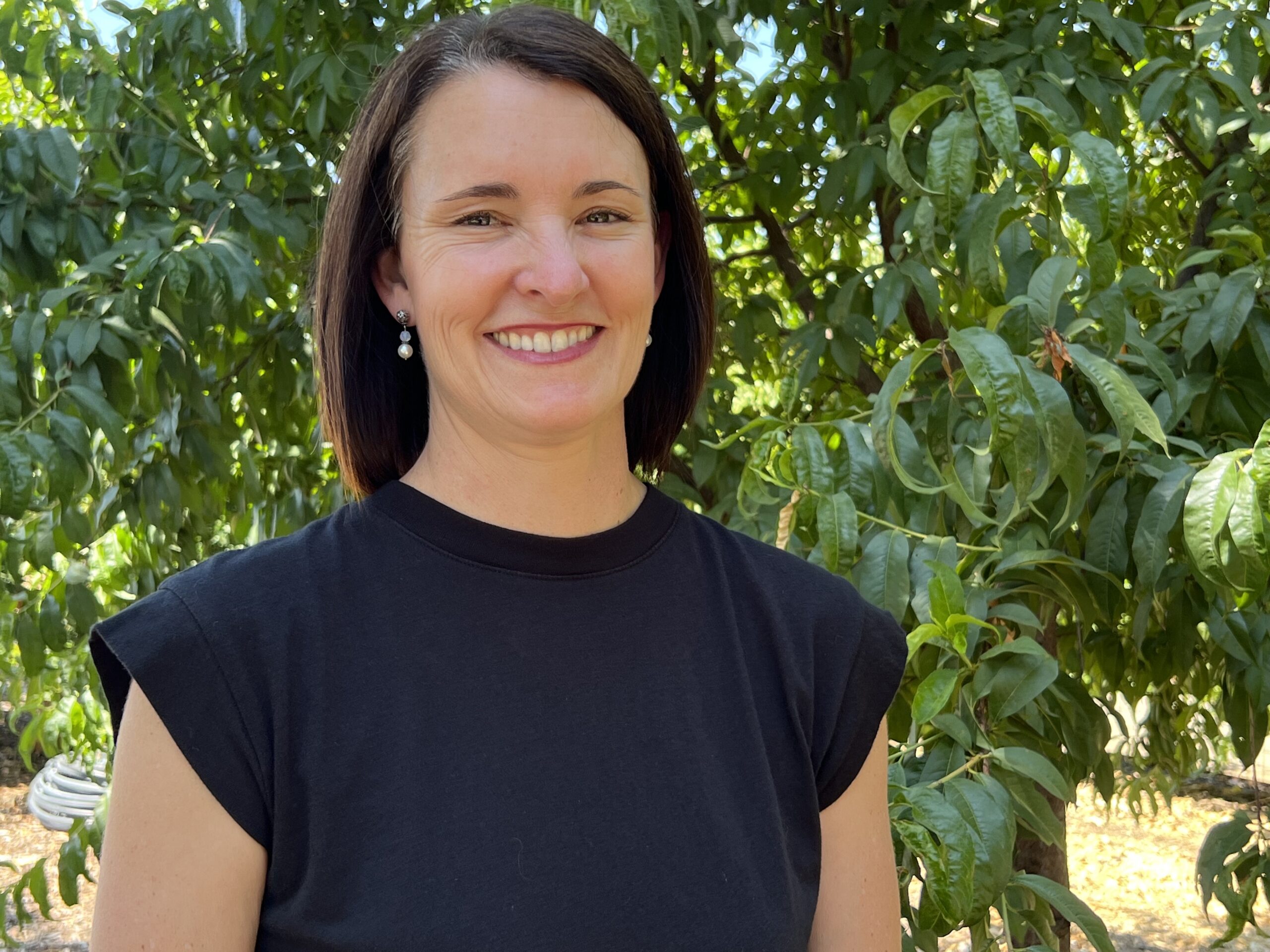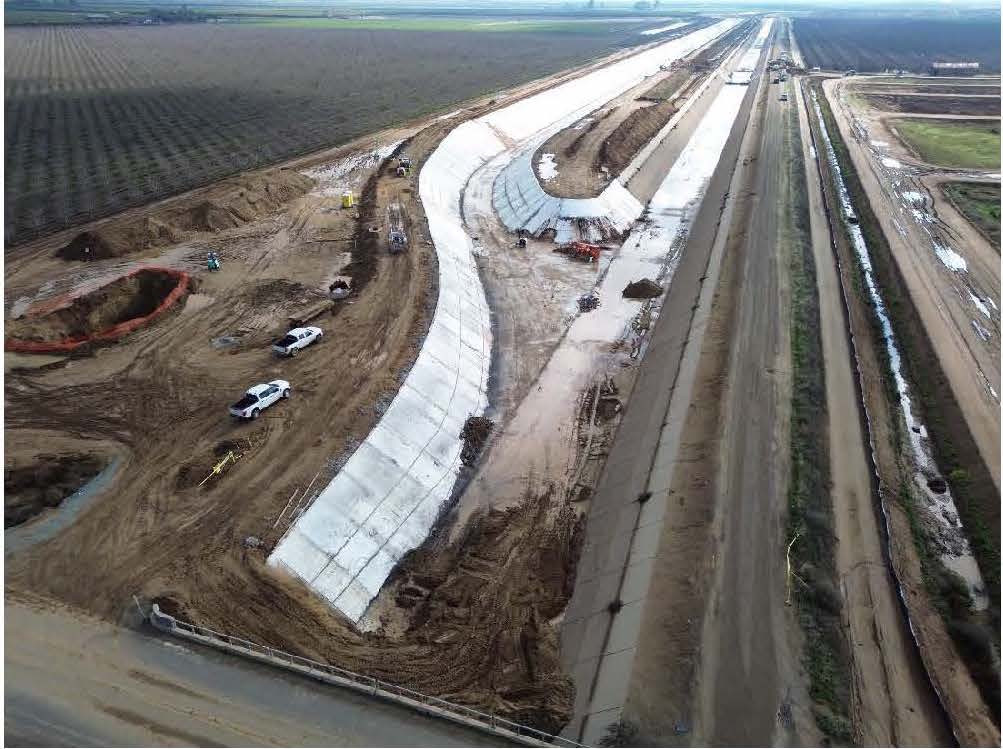Farmers in Tulare County are being allowed to continue pumping so much groundwater that it is endangering a newly constructed portion of the Friant-Kern Canal that had to be rebuilt because overpumping had sunk a 33-mile section of the canal, according to a lawsuit filed Friday.
Land around the new canal section has continued to sink at a much faster rate than initially envisioned, said Johnny Amaral, chief operating officer of Friant Water Authority, which filed the lawsuit along with the Arvin-Edison Water Storage District.
“To make matters worse,” Amaral continued, “there are new cones of subsidence upstream and downstream of the realigned canal that are causing concern.”
A new canal had to be built next to the existing canal, which had sunk from about Pixley in Tulare County to the Kern County border. That “sag” reduced the canal’s carrying capacity by nearly 60 percent.
That capacity crimp has been especially hard on Arvin-Edison, which sits at the end of the Friant-Kern Canal’s 152-mile run and contracts for 350,000 acre feet annually.
If the current rate of subsidence – projected at one foot a year – continues, it will “reduce long-term deliveries by nearly 100,000 acre-feet per year” to Arvin-Edison, according to the lawsuit.
The first phase of construction on a 10 mile section is expected to be completed and water flowing in the canal by the end of march.

Friday’s lawsuit was filed against the Eastern Tule Groundwater Sustainability Agency, which is responsible for enacting a plan to reduce groundwater pumping under the state’s Sustainable Groundwater Management Act.
Much of the land covered by Eastern Tule GSA isn’t covered by any water districts, which pay to bring in imported water. Because of that many Eastern Tule farmers rely heavily on groundwater.
“We have been working to the best of our ability on the mitigation side of over pumping and ramping up efforts in our management zones,” said Eastern Tule Manager Rogelio Caudillo. “It’s a lot of work we’ve had to do, but we’re definitely getting there.”
Friant disagrees.
Eastern Tule’s plan is far too liberal with how much groundwater it allows farmers to pump and how much native water it credits to farmers, according to the lawsuit.
The complaint also alleges that Eastern Tule has failed to charge its farmers high enough overpumping penalties that reflect actual consumption in order to bring in $200 million, which is needed by Friant for the canal reconstruction.
Some onlookers have speculated that $200 million is the real crux behind the lawsuit as it makes up a substantial portion of Friant’s $300 million funding mix to rebuild the canal. Some of that money came from federal and state sources and some from other Friant contractors, who complained that the farmers who caused the canal to sink should pay their share.
In fact, Friant and Arvin-Edison entered into a settlement agreement with Eastern Tule back in 2021 that recognizes subsidence will continue and lays out pumping penalties to help pay for that damage.
Caudillo with Eastern Tule told SJV Water, “We have been honoring the settlement since we implemented it.”
He added that as of its Feb. 1 board meeting, Eastern Tule has paid Friant more than $16 million to address subsidence issues with the canal.
The payments have been coming in slower and lower than anticipated, though, as Eastern Tule’s water accounting system gave its farmers what Friant contractors felt was more water “credits” than existed in reality. That has resulted in an inaccurate view of actual groundwater consumption and, of course, lower penalty payments, according to Friant contractors.
“It’s a big shell game that they’re playing with their precipitation and the way their market works, which is leading to some of the subsidence,” said Jeevan Muhar, general manager at Arvin-Edison. he said. “We’ve been sharing ideas that are not sticking on the other side.”

Along with the lawsuit, Eastern Tule is facing possible probation under SGMA by the Water Resources Control board after its groundwater plan was found “inadequate.” Its first hearing is scheduled this coming September.
Eric Quinley, general manager at Delano-Earlimart Irrigation District, said after ten years of the SGMA, the Tule subbasin still is not seeing changes in unsustainable pumping
quickly enough.
“And that’s evidenced by what’s going on with the Friant-Kern Canal,” he said.
Share this:
- Click to share on Facebook (Opens in new window)
- Click to share on Twitter (Opens in new window)
- Click to share on LinkedIn (Opens in new window)
- Click to share on Reddit (Opens in new window)
- Click to share on Tumblr (Opens in new window)
- Click to share on Pinterest (Opens in new window)
- Click to share on Pocket (Opens in new window)
- Click to share on Telegram (Opens in new window)
- Click to share on WhatsApp (Opens in new window)
- Click to print (Opens in new window)









You must be logged in to post a comment.